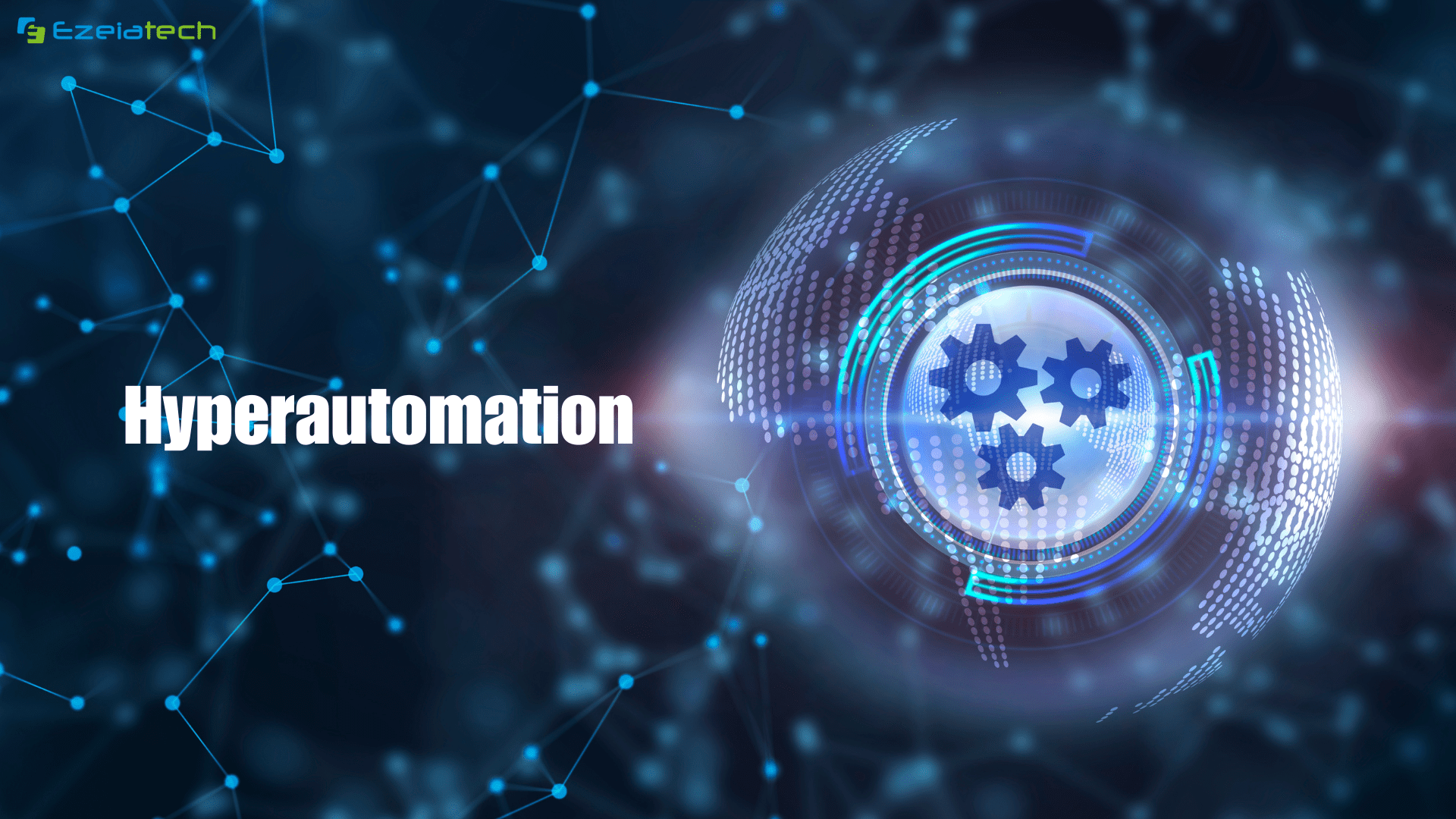Welcome to our comprehensive guide on hyperautomation, a transformative concept revolutionizing businesses worldwide. In this article, we will delve into hyperautomation, its key trends, the technologies driving its adoption, and effective implementation strategies. Hyperautomation is at the forefront of the digital transformation movement, empowering organizations to optimize their processes and operations.
As organizations strive to stay competitive in today’s rapidly evolving business landscape, hyperautomation offers a compelling solution. By harnessing cutting-edge technologies and embracing automation, businesses can streamline their workflows and achieve unparalleled efficiency.
Throughout this article, we will discuss hyperautomation trends, exploring real-world examples and success stories that highlight its transformative power. We will also shed light on the essential technologies underpinning hyperautomation, such as artificial intelligence, machine learning, and robotic process automation.
Moreover, we will guide you through effective implementation strategies for integrating hyperautomation into your organization. From identifying suitable processes for automation to selecting the right technologies, our insights will help pave the way for success.
Join us on this journey as we explore the world of hyperautomation, uncover the latest trends, and provide valuable insights into its implementation strategies. Together, we will unlock the full potential of hyperautomation to drive digital transformation and secure a competitive edge in the modern business landscape.
What is Hyperautomation?
Hyperautomation is a revolutionary approach that combines various technologies to transform and optimize business processes. This powerful concept integrates intelligent automation, process automation, artificial intelligence (AI), machine learning (ML), and robotic process automation (RPA) to drive efficiency, enhance productivity, and enable digital transformation.
Intelligent automation refers to the use of advanced technologies, such as AI and ML, to automate and streamline complex tasks that previously required human intervention. It leverages algorithms and data analytics to make informed decisions and carry out actions with minimal human intervention.
Process automation focuses on automating repetitive and rule-based tasks to improve accuracy, speed, and consistency. By eliminating manual interventions, organizations can reduce errors, enhance compliance, and free up their workforce to focus on value-added activities.
With the integration of artificial intelligence and machine learning, hyperautomation enables systems to learn from past data, adapt to changing circumstances, and make intelligent decisions. This empowers businesses to automate increasingly complex processes and improve overall agility and flexibility.
Robotic process automation, on the other hand, involves the use of software robots or “bots” to automate repetitive tasks across different systems. These bots can interact with applications, retrieve data, perform calculations, and execute actions, just like humans, but with greater speed and accuracy.
Hyperautomation leverages the full potential of these automation technologies to create a seamless, end-to-end automation ecosystem. By combining the strengths of different technologies, it enables organizations to optimize their operations, deliver enhanced customer experiences, and unlock new opportunities for growth.
Hyperautomation Trends
As organizations navigate the digital transformation journey, hyperautomation has emerged as a key enabler for achieving operational excellence and competitive advantage. By leveraging a combination of automation technologies, businesses are revolutionizing their processes and adapting to the rapidly evolving business landscape. In this section, we will explore the latest trends and developments in hyperautomation, providing insights into the future of automation technology.
The Rise of AI for Hyperautomation
Artificial intelligence (AI) plays a pivotal role in enabling hyperautomation. By leveraging machine learning algorithms and advanced analytics, organizations can automate complex tasks, make data-driven decisions, and improve operational efficiency. AI-powered technologies are transforming industries, from healthcare and finance to manufacturing and retail. These technologies can intelligently analyze large data sets, predict outcomes, and automate repetitive tasks, allowing businesses to allocate resources more effectively and focus on strategic initiatives.
The Impact of Robotic Process Automation (RPA)
Robotic Process Automation (RPA) is a vital component of hyperautomation. RPA software robots can mimic human actions and perform rule-based tasks, allowing organizations to automate high-volume, repetitive processes. By automating mundane tasks, employees can focus on more meaningful and value-added work, improving productivity and job satisfaction. RPA has gained immense popularity across industries, driving increased efficiency, accuracy, and cost savings.
The Convergence of Technologies
Hyperautomation involves the convergence of various technologies, including AI, machine learning, data analytics, and process automation. This convergence enables organizations to streamline and optimize end-to-end processes across departments and functions. By integrating these technologies, businesses can achieve a higher level of orchestration, improve data accuracy, and enhance collaboration between humans and machines. The result is a seamless, efficient, and intelligent operation that drives digital transformation.
Industry-Specific Hyperautomation Solutions
Hyperautomation trends are also specific to different industries, as businesses tailor automation solutions to meet their unique requirements. For example, in healthcare, hyperautomation can facilitate patient data management, streamline billing processes, and enhance medical decision support. In manufacturing, hyperautomation can optimize supply chain operations, improve quality control, and enable predictive maintenance. Understanding industry-specific trends and challenges is crucial for organizations to effectively implement hyperautomation solutions and drive sector-specific digital transformation.
| Trend | Description |
|---|---|
| Intelligent Document Processing | Automating the extraction and processing of data from unstructured documents, such as invoices, contracts, and forms, using AI technologies. |
| Process Discovery and Mining | Using process mining techniques to analyze data logs and identify opportunities for process optimization and automation. |
| Hyperautomation-as-a-Service | Cloud-based platforms and services that offer hyperautomation capabilities, allowing organizations to scale their automation initiatives easily. |
| Intelligent Automation Centers of Excellence | Establishing dedicated teams and resources to drive automation initiatives, develop best practices, and promote organizational adoption of hyperautomation. |
These trends illustrate the innovative and evolving nature of hyperautomation. By staying informed about the latest technologies and industry-specific solutions, organizations can leverage hyperautomation to accelerate their digital transformation journeys and gain a competitive edge in today’s dynamic business environment.
Key Hyperautomation Technologies
Hyperautomation, the integration of various advanced technologies, is revolutionizing the way organizations automate their processes. In this section, we will explore the key technologies that underpin hyperautomation and enable organizations to achieve unparalleled levels of efficiency and productivity.
1. Artificial Intelligence (AI)
Artificial Intelligence is a critical component of hyperautomation, empowering systems to perform tasks that would typically require human intelligence. AI algorithms analyze large volumes of data, identify patterns, and make informed decisions, driving automation and enhancing business operations. Machine learning algorithms, a subset of AI, enable systems to learn from data and improve their performance over time.
Example: In customer service, AI-powered chatbots can interact with customers, understand their queries, and provide relevant solutions or escalate complex issues to human agents.
2. Robotic Process Automation (RPA)
Robotic Process Automation enables organizations to automate repetitive and rule-based tasks by employing software robots or “bots.” These bots mimic human actions on user interfaces, interact with various applications, and perform tasks with speed, accuracy, and consistency. RPA reduces manual effort, eliminates errors, and frees up employees to focus on more strategic activities.
Example: In finance, RPA can automate the data entry process, extract information from invoices, reconcile accounts, and generate financial reports, improving efficiency and reducing human error.
3. Machine Learning (ML)
Machine Learning, a subset of AI, equips systems with the ability to automatically learn and improve from experience without being explicitly programmed. ML algorithms analyze data, identify patterns, and make predictions or decisions. By continuously learning and adapting, ML algorithms enhance the accuracy and effectiveness of automation processes.
Example: In supply chain management, ML algorithms can analyze historical sales data, forecast demand, optimize inventory levels, and automate procurement processes, leading to improved inventory management and cost savings.
Effective Implementation Strategies
Implementing hyperautomation requires careful planning and execution. To ensure successful implementation within your organization, we will discuss effective strategies and best practices. By following these actionable insights, businesses can achieve their automation goals and maximize the benefits of hyperautomation technologies.
1. Identify Suitable Processes for Automation:
Begin by analyzing your current business processes to identify those that can be automated for maximum efficiency gains. Look for repetitive and rule-based tasks that consume significant time and resources. These processes present the greatest potential for automation, allowing your employees to focus on higher-value activities.
2. Choose the Right Hyperautomation Technologies:
There are various hyperautomation technologies available, including artificial intelligence (AI), machine learning (ML), and robotic process automation (RPA). Assess your organization’s specific needs and select the technologies that align with your automation objectives. Consider factors such as ease of integration, scalability, and compatibility with existing systems.
3. Foster Collaboration and Alignment:
Implementing hyperautomation requires collaboration and alignment across different teams and departments within your organization. Encourage open communication and ensure that all stakeholders are involved from the early stages of the implementation process. This will facilitate a smooth transition and enable a comprehensive understanding of the benefits and impacts of automation.
4. Plan for Change Management:
Automation often brings significant changes to existing processes, workflows, and job responsibilities. Develop a change management plan to address potential resistance and ensure a smooth transition for your employees. This includes providing adequate training, fostering a culture of continuous learning, and clearly communicating the positive impact automation will have on their roles.
5. Implement in Phases:
Instead of attempting a big-bang approach, consider implementing hyperautomation in phases. Start with a small-scale pilot project to test the effectiveness of automation technologies and gather valuable feedback. This iterative approach allows for adjustments and refinements before scaling up automation efforts across the organization.
6. Monitor, Measure, and Optimize:
Once hyperautomation is implemented, the journey doesn’t end there. Continuously monitor and measure the performance of automated processes to identify areas for improvement. Use key metrics and analytics to evaluate the effectiveness of automation and make data-driven decisions to optimize processes further.
7. Embrace a Culture of Innovation:
Hyperautomation is an ongoing journey of innovation and improvement. Encourage your team to think creatively and embrace new automation opportunities. Foster a culture that rewards innovation, provides resources for experimentation, and celebrates automation successes. This will ensure that your organization stays at the forefront of automation technology advancements.
| Strategy | Key Points |
|---|---|
| Identify Suitable Processes for Automation | – Analyze current processes and identify repetitive and rule-based tasks – Focus on tasks that consume significant time and resources |
| Choose the Right Hyperautomation Technologies | – Assess organization’s needs and select technologies that align with automation objectives – Consider ease of integration, scalability, and compatibility with existing systems |
| Foster Collaboration and Alignment | – Encourage open communication and involvement of all stakeholders – Ensure comprehensive understanding of benefits and impacts of automation |
| Plan for Change Management | – Develop a change management plan to address potential resistance – Provide training and clearly communicate the positive impact on employee roles |
| Implement in Phases | – Start with small-scale pilot project – Test and refine automation technologies – Scale up automation efforts gradually |
| Monitor, Measure, and Optimize | – Continuously monitor and measure automated processes – Identify areas for improvement and make data-driven decisions |
| Embrace a Culture of Innovation | – Encourage creative thinking and new automation opportunities – Reward innovation and provide resources for experimentation |
Conclusion
In conclusion, hyperautomation is a transformative concept that holds significant promise for organizations aiming to optimize their processes, boost productivity, and drive digital transformation. By embracing hyperautomation and keeping pace with the latest trends in the industry, businesses can unlock new levels of efficiency and gain a competitive edge in their respective markets.
Successful implementation of hyperautomation requires a strategic approach and a deep understanding of the underlying technologies involved. Organizations need to carefully select and leverage the right hyperautomation technologies, such as artificial intelligence, machine learning, and robotic process automation, to automate complex and diverse processes.
While the journey towards hyperautomation may pose challenges, the benefits it offers are game-changing. With hyperautomation, organizations can streamline operations, reduce costs, and improve customer experiences. By embracing automation, businesses can position themselves for future growth and stay ahead in the ever-evolving digital landscape.
Thank you for reading. For continued insights and in-depth discussions, please follow our blogs at Ezeiatech







